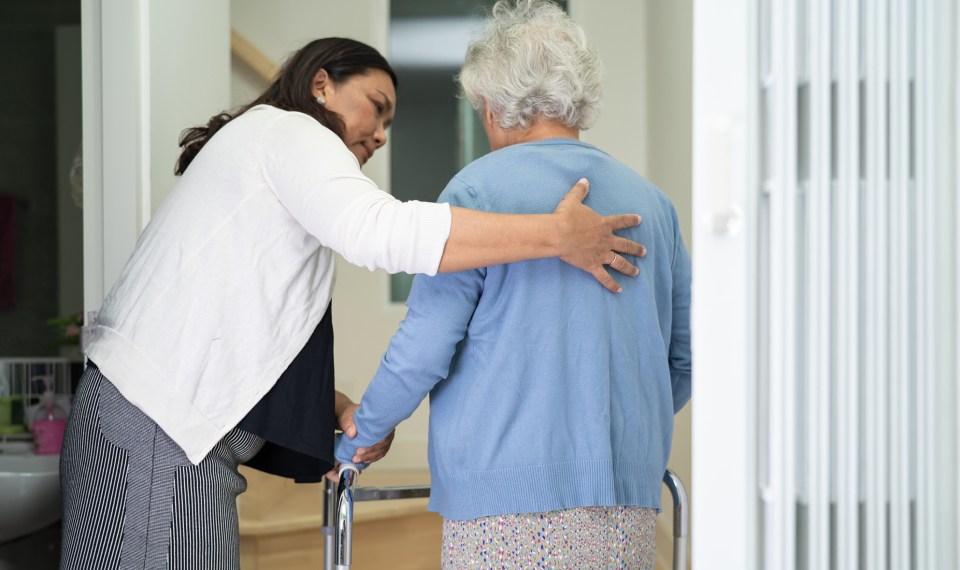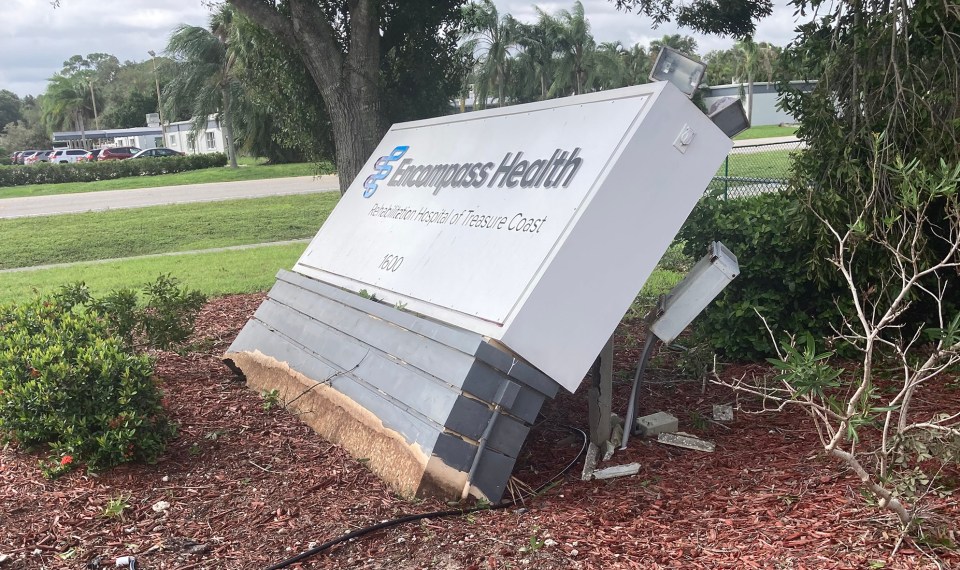Falls are a major concern for older adults and can lead to other complications and even death.
Falls account for more than 3 million emergency department visits each year, making them the leading cause of injuries among older adults.
Many falls in older adults can be caused by cognitive impairments, such as dementia. As occupational therapists, we have a variety of evidenced-based assessments and interventions we can incorporate into our practice to reduce the risk of falls for older adults with cognitive impairments.
Cognition and Fall Risks
The prevalence of falls in the elderly with cognitive impairments is close to 60%. Those with dementia fall at eight times the rate of those without and are much more likely to be hospitalized.
Cognitive impairments can be accompanied with gait decline. Many older adults who live independently report restricting their involvement in activities of daily living (ADLs) and instrumental activities of daily living (iADLs) because they have a fear of falling.
A fear of falling can be caused by:
- Receiving physical injuries from a past fall
- The loss of their ability to live independently
- Worry about becoming a burden to loved ones
- Feelings of shame or embarrassment
Because of this fear of falling, older adults could become less mobile and have a decreased willingness to engage in ADLs and iADLs, which in turn leads to further decreased mobility and ultimately loss of independence. A fear of falling also increases anxiety and depression, which impacts self-efficacy and further restricts activity.
Why Occupational Therapy?
Occupational therapy professionals continually assess and problem-solve their patients’ environments, personal factors, goals, valued activities, emotions and nearly every other part of their being—including fall prevention.
Occupational therapists can perform activity analysis to understand why patients are unable to perform the tasks they find important.
When it comes to fall prevention, occupational therapists and occupational therapy assistants can assess and treat:
- Safety with mobilizing and performing daily routines
- Home setup and environmental modifications such as removing rugs or adding lighting
- Adapting seated or standing self-care for safer reaching
- Community mobility and safety while navigating varying environments and surfaces
- Increasing participation in leisure tasks for improved quality of life
- Rest and sleep necessary for safety awareness throughout the day
- Medication management and knowledge of potential interactions that increase fall risk
- Vision changes that may disrupt their perception of the world
- Valued relationships and available assistance to increase safety and participation
- Pets and children that may present a risk of falls
- Activity demands throughout the day and how these impact the risk of falling and fatigue
- Balance and strength
- Anxiety and fear, which may contribute to our perception of safety versus risk
- Anything that is meaningful to the patients
Assessments/ Evaluation
Cognitive and visual impairments can put patients, especially those in the inpatient rehabilitation setting, at a higher risk of falling. There are several assessments and tools that can assist occupational therapists in determining the cognitive deficits and fall risks of a patient.
- The Fear of Falling Questionnaire is a questionnaire that can be used to obtain a better understanding as to how a patient’s ability to perform ADLs or iADLs has been impacted by their fear of falling.
- The Twelve Item Walking Scale is a questionnaire that was originally designed for patients with multiple sclerosis. However, the questions can be easily altered to pertain to any diagnosis. This questionnaire is a fast, simple and measurable assessment that could be used to help you understand how your patient feels their mobility has been affected.
- The Trail Making Test is another quick and simple assessment. If your hospital has a Bioness Integrated Therapy System (BITS) you can locate the assessment there, or it can be completed on paper. The Trail Making Test is a cognitive assessment that can assess processing speed, attention and executive functioning, which can all impact the decision-making, balance and ambulation required to perform ADL/iADL tasks.
- BIMS, or Brief Interview for Mental Status, is a simple and quick cognitive screening. If patient scores are equal to or less than seven, the patient meets the definition of cognitive impairment.
- Formal Visual assessment is a vision screening assessing the patient’s visual fields, scanning, saccades, convergence, contrast sensitivity, pursuits and oculomotor control.
Treatment
When considering the most effective treatment options for older adults with cognitive impairment, first, you should ensure that the treatment option selected is individualized to address their specific cognitive deficit. There should also be an emphasis on early caregiver or family involvement in training and education on fall prevention.
Mild Cognitive Impairment
Remember that new learning is possible for older adults with mild cognitive impairment. The following techniques can help ensure your patients understand instructions:
- The Teach Back Method allows your patient to demonstrate or teach newly learned techniques back to the therapist proving a high level of learning and retention.
- The Ask Me3 Method is an educational program that encourages patients and families to ask three specific questions of their providers to better understand their health conditions and what they need to do to stay healthy.
Since new learning is possible for older adults with mild cognitive impairment, you should also tap into their declarative and procedural learning. Declarative knowledge is knowledge of a concept or idea. For example, patients can be taught that as age increases, so does the risk of falling. Procedural knowledge is the knowledge of a process, skill or procedure. For example, patients can learn the safe use of assistive devices for mobility.
Moderate to Severe Cognitive Impairment
Individuals with moderate to severe cognitive impairment could be more impulsive and are likely to make unsafe decisions. Occupational therapist can assist them by:
- Organizing frequent, intentional rounding with an emphasis on asking them questions about the 4 Ps—Pain, Position, Possessions and Personal Needs.
- Scheduling individualized toileting with scripted prompts such as, “Can I assist you to the bathroom now or in five minutes?”
OTs can also assist with environmental modifications, which should be emphasized with this patient population. Modifications could include:
- Proper bed height. The patient should be in 90 degrees of flexion at the hips and knees while seated at edge of bed
- Safe exit side. Their environment should allow for safe mobility until someone can respond and assist. Make sure there is a clear pathway from the bed or chair to the bathroom and that their assistive device is within their reach and a fall mat is in place. Consider using bed and chair alarms.
- Toilet access and placement (bedside commode vs. raised toilet seat). Toilet height should allow for a seated position with knees and hips flexed at 90 degrees. Grab bars can help them in getting up and down. Also, make sure they have proper, non-skid, supportive footwear when using the bathroom. Non-skid socks should not be universal for patients.
- Caregiver resources. Administration for Community Living provides information on fall prevention that includes conversation guides for caregivers, and an exercise and physical activity guide in written pdf, and video formats.
Encompass Health occupational therapists Courtnie White, Karen Ford, Morgan Davis, Curtis Blue Jr., Caroline Boerding and Austin Sparks contributed to the research and writing of this post.
References
- Coordinated Care Plan to Prevent Older Adult Falls/steadi Stopping Elderly Accidents, Deaths & Injuries. (n.d.). https://www.cdc.gov/steadi/pdf/Steadi-Coordinated-Care-Plan.pdf
- Ansai, J. H., De Andrade, L. P., Masse, F. a. A., Gonçalves, J., De Medeiros Takahashi, A. C., Vale, F. a. C., & Rebelatto, J. R. (2019). Risk Factors for Falls in Older Adults With Mild Cognitive Impairment and Mild Alzheimer Disease. Journal of Geriatric Physical Therapy, 42(3), E116–E121. https://doi.org/10.1519/jpt.0000000000000135
- Montero-Odasso M, Muir SW, Speechley M. Dual-task complexity affects gait in people with mild cognitive impairment: the interplay between gait variability, dual tasking, and risk of falls. Arch Phys Med Rehabil. 2012;93(2):293–299.
- Leroy, V., Martinet, V., Nunkessore, O., Dentel, C., Durand, H., Mockler, D., Puisieux, F., Fougère, B., & Chen, Y. (2023). The Nebulous Association between Cognitive Impairment and Falls in Older Adults: A Systematic Review of the Literature. International Journal of Environmental Research and Public Health, 20(3). https://doi.org/10.3390/ijerph20032628
- Newton, M., & Sanderson, A. (2013). The effect of visual impairment on patients’ falls risk. Nursing Older People. https://doi.org/10.7748/nop2013.10.25.8.16.e489
- Penn Asian Senior Services. (2021b, April 25). The Warning Signs of a Fall, and How to Prevent it – Penn Asian Senior Services
- Falls Prevention Resources for Older Adults and Caregivers | ACL Administration for Community Living. (n.d.). https://acl.gov/FallsPrevention
- American Occupational Therapy Association. (2020). Occupational therapy practice framework: Domain and process (4th ed.). American Journal of Occupational Therapy, 74(Suppl. 2), 7412410010. https://doi. Org/10.5014/ajot.2020.74S2001
- Tinetti, M.E., Richman, D., & Powell, L. (1990). Falls efficacy as a measure of fear of falling Journal of Gerontology, 45, 239-243.
- Sage Publications Ltd. (n.d.). The Trail Making test : a study of its ability to predict falls in the acute neurological in-patient population – WRAP: Warwick Research Archive Portal
- Falls Prevention Resources for Older Adults and Caregivers. (n.d.) https://acl.gov/FallsPrevention
- Liu, M., Hou, T., Li, Y., Sun, X., Szanton, S. L., Clemson, L., & Davidson, P. M. (2021). Fear of falling is as important as multiple previous falls in terms of limiting daily activities: a longitudinal study. BMC Geriatrics (Vol. 21, Issue 1). Springer Science and Business Media LLC. https://doi.org/10.1186/s12877-021-02305-8.
- Painter, J.A., Allision, L., Dhingra, P., Daughtery, J., Cogdill, K., & Trujilio, L. G. (2012). Fear of falling and its relationship with anxiety, depression, and activity engagement among community-dwelling older adults. American Journal of Occupational Therapy, 66, 169-176. http://dx.doi.org/10.5014/ajot.2012.002535.
- Zhang, W., Low, L., Schwenk, M., Mills, N. L., Gwynn, J., & Clemson, L. (2019). Review of Gait, Cognition, and Fall Risks with Implications for Fall Prevention in Older Adults with Dementia. Dementia and Geriatric Cognitive Disorders, 48(1–2), 17–29. https://doi.org/10.1159/000504340
The content of this site is for informational purposes only and should not be taken as professional medical advice. Always seek the advice of your physician or other qualified healthcare provider with any questions you may have regarding any medical conditions or treatments.



